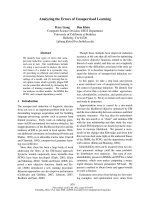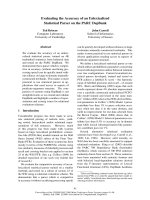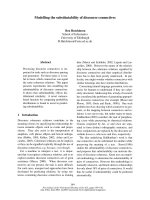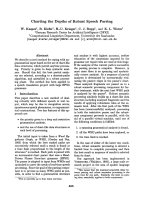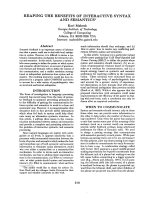Báo cáo khoa học: "Coding the Russian Alphabet for the Purpose of Mechanical Translation" pptx
Bạn đang xem bản rút gọn của tài liệu. Xem và tải ngay bản đầy đủ của tài liệu tại đây (148.64 KB, 4 trang )
[
Mechanical Translation
, Vol.7, no.2, August 1963]
Coding the Russian Alphabet for the Purpose of Mechanical Translation
by John Lyons,† School of Oriental and African Studies, University of London
If we take advantage of our knowledge of the phonological characteristics
of Russian and their orthographic representation, it is possible to intro-
duce a number of simple transformations operating on the text at input,
the effect of which is to reduce the number of affixes and simplify the
morphological analysis.
It is well known that there is in Russian a phonolog-
ical opposition between palatalized and non-palatalized
consonants (or, in the traditional terminology, between
“soft” and “hard” consonants). This palatalization is
marked in the Russian orthography by the use of one
of the set of “soft” vowels or by the special “soft sign”
according to whether the palatalized consonant is fol-
lowed by a vowel or not. This immediately suggests the
possibility of replacing the “soft” vowels by the “soft
sign” + the corresponding “hard” vowels. Thus “Я”
would be transformed into *ЬА, “Ю” into *ЬУ, etc.
1
Furthermore, the “soft sign” and the letter Й are in
complementary distribution, the “soft sign” being writ-
ten after a consonant and Й being written after a vowel.
They may therefore be regarded as “allographs” of the
same “grapheme” and represented by the same symbol,
Ь. The transformations suggested so far are listed here
for convenience:
Я → *ЬА
Е → *ЬО
Ю → *ЬУ (1)
И → *Ь Ы
Й → *Ь
The effect of these transformations operating on the text
at input is not merely to reduce the number of symbols
required by five but, more important, to reveal identi-
ties in the “hard” and “soft” declensions and conjuga-
tions which the Russian orthography tends to conceal.
This will be clear from Table 1.
In certain positions in Russian there is what some
linguists would call “neutralization” of the palatal non-
palatal opposition. That is to say that certain consonants
† The ideas described in this paper were developed while the author
was working as linguistic consultant to the group engaged on mechan-
ical translation at the National Physical Laboratory, Teddington,
Middlesex, England, in August, 1939. Although it was decided not
to make use of them at the time, it has seemed worthwhile putting
them forward for discussion.
1
The asterisk is used throughout this paper to distinguish the trans-
formed spellings assumed by words inside the computer from the
orthographic forms in which they arc met in the text to be translated.
are necessarily either hard or soft. The orthographical
conventions of Russian reflect this phonological neutral-
ization, although, for historical reasons, they are no
longer in complete accord with contemporary phonetic
realization in their prescription of the particular vowels
permitted after these consonants. A great simplification
is effected in the declensions and conjugations of those
lexemes whose stems end in one of these consonants if
we introduce the following transformations to operate
before the transformations in (1):
(a) After Ш, Ж, Щ, Ч, Ц; А → *Я
У → *Ю
(b) Final Ш, Ж, Щ, Ч, Ц → *Ш6, *ЖЬ, etc. (3)
(c) After Ц; Ы → И (4)
(d) After К, Г, Х; И → *Ы (5)
The effect of these transformations will be clear from
Table 2.
The letter O appears after the letters Ш, Ж, Щ, Ц, Ч
only when the syllable in which it occurs is under stress
and not consistently then (since Е [i.e. Ё] may be
written). We thus have marked orthographically the
distinction between БОЛЬШЕЙ (“greater”) and
БОЛЬШОЙ (“great”), though in other cases of these
same words, which differ similarly in stress, the distinc-
tion is not marked: cf. БОЛЬШИМ and БОЛЬШИМ.
It is evident that the effect of the transformations so far
mentioned will be to preserve the distinction between
these words when the orthography recognizes the dis-
tinction, but only at the price of creating two stems for
the finally-stressed word: cf.
*БОЛЬШЬ—ОЬ, *БОЛЬШ—ЫМ
but *БОЛЬШ—ОЬ, БОЛЬШЬ—ЫМ (1)
We are now faced with the necessity of deciding
among several more or less undesirable solutions to this
problem.
Since the number of pairs of words in which there
will be minimal contrast consisting in the opposition
between Е and О after Ш, Щ, Ж, Ч and Ц, is very
small (but exactly how small it is impossible to say in
advance) we could introduce a transformation.
43
TABLE 1
СТОЛ СЛОВАРЬ СЛОЙ → *СТОЛ—Ф *СЛОВАРЬ—Ф *СЛОЬ—Ф
СТОЛА СЛОВАРЯ СЛОЯ → —А —А —А
СТОЛУ СЛОВАРЮ СЛОЮ → —У —У —У
СТОЛОМ СЛОВАРЕМ СЛОЕМ → —ОМ —ОМ —ОМ
CTOJIЕ CЛOBAPЕ СЛОЕ → —ЬО —О —О
CTOJIЫ CЛOBAPИ СЛОИ → —Ы —Ы —Ы
CTOJIАМ CЛOBAPЯМ СЛОЯМ → —АМ —АМ —АМ
Note that the symbol “ф” stands for the zero-affix.
After Ш, Ж, Ч, Щ and Ц; О → *Е (6)
The effect of this would be, for example, to change
БОЛЬШОЙ into *БОЛЬШЕЙ (whence ultimately
by (1) to *БОЛЬШЬОЬ) and thus to destroy the
orthographical difference which exists in the text be-
tween certain forms of the comparative and the positive
of this adjective. It is worth noting, in this connection,
that those forms of the comparative and positive which
differ, in stress but not in orthography (cf. БОЛЬШИМ:
БОЛЬШИМ) are frequently distinguished in Russian
typographical practice by printing an acute over the
stressed syllable in the comparative. This suggests that
even the native Russian might be momentarily in doubt
about the interpretation and unable to decide from the
immediate environment of the word whether it is the
positive or comparative. It certainly seems gratuitous
to throw away information when we have it, if the
lack of this information is going to cause difficulties of
interpretation later.
2
We should, therefore, be reluctant
2
It seems to be widely assumed by MT groups working on Russian
that they will not have to have techniques available for coding
stress. Although a stress mark is printed only exceptionally in Russian,
it is precisely because the orthography is ambiguous and the
ambiguity is not easily resolved from context that the diacritic is
printed. This would seem to indicate that a technique should be at
hand for encoding the information given. From this point of view the
Ё when printed should be regarded as Е + diacritic since it may have
been printed in order to avoid possible ambiguity, e.g., a confusion
between ВСЁ and ВСЕ.
TABLE 2
НОЖ → *НОЖЬ—
НОЖА → *НОЖЬ—A
НОЖЕМ → *НОЖЬ—ОМ
НОЖИ → *НОЖЬ—Ы
ТАБЛИЦА → *ТАБЛИЦЬ—A
ТАБЛИЦУ → *ТАБЛИЦЬ—У
ТАБЛИЦЕЙ → *ТАБЛИЦЬ—ЬОЬ
ТАБЛИЦЫ → *ТАБЛИЦЬ—Ы
ДЕЛАЮЩИЙ → *ДЕЛАЬЫЩЬ—ЫЬ
СДЕЛАННЫЙ → *СДЕЛАНН—ЫЬ
ДЕЛАЮЩЕГО → *ДЕЛАЬУЩЬ—ОГО
СДЕЛАННОГО → *СДЕЛАНН—ОГО
to introduce a transformation of the form (6) until we
are perfectly certain that the information thus lost is
of no further use to us.
Another possibility which suggests itself is that of
increasing the number of affixes. Such would be the
effect, for example, of introducing a transformation of
the form:
After Ш, Ж, Ч, Щ and Ц; О → *ЬЕ (7)
Under this rule, БОЛЬШОЙ would become
*БОЛЬШЬЕЙ and ultimately *БОЛЬШЬ—ЬОЬ.
The result would be satisfactory in that it yields one
stem without loss of information, but unsatisfactory in
that it would lead to a considerable increase in the list
of affixes.
It is now worth enquiring whether having to code
two stems in the dictionary is such a bad thing after all.
It would seem to be desirable, from many points of
view, to have two kinds of stems in a Russian auto-
matic dictionary: “false stems” and “true stems”. With
the “false stems” will be coded an indication of what
addition must be made to arrive at the morphologically
acceptable or “true” stem; with the “true stems” there
will be given in the dictionary the grammatical and
lexical information required for translation. With the
techniques available for the treatment of “false stems”
in the dictionary it is possible to enter the stem
*БОЛЬШ which results from the splitting off of the
affix *ОЬ as one among a number of “false stems” in
the dictionary. And the possibility of doing this would
make the application of the orthographic transformations
suggested here more satisfactory.
It will be evident from the list of affixes given in
Table 3 that whenever there is a pair of affixes one of
which includes the other as a right-hand subpart of
itself any automatic splitting routine is liable to produce
what is, linguistically speaking, a false split. Take, for
example, the affixes *A and *ЬA, the first of which we
should wish to regard as the genitival desinence in the
word “СЛОЯ” (→ *СЛОЬ—A) and the second of
which we would regard as the gerundival desinence in
the word “ДЕЛАЯ” (→ *ДЕЛА—ЬА). It is prob-
ably more economical to arrange that the largest right-
hand segment of the word which matches one of the
list of affixes is always automatically split off and to
44
LYONS
TABLE 3
LIST OF RUSSIAN AFFIXES SHOWING THE POSSIBILITY OF
FALSE SPLITS
A ЬА AЬA
ЛА ЬЛА
У ЬУ УЬУ
ОМУ
Ы АМЬЫ
ЫМЬЫ
ЛЬЫ ЫЛЬЫ
ТЬЫ
ШЬЫ ВШЬЫ ЫВШЬЫ
О ЬО ОЬО
ЫЬО
ТЬО
ЬТЬО
ЫТЬО
ьотьо
ЛО ЫЛО
ОГО
В ОВ
ЫВ
Ь ОЬ
ЫЬ
ТЬ ЫТЬ
ЫШЬ
ЬОШЬ
Л ЫЛ
ОМ ЬОМ
УТ ЬУТ
АМ
АХ
АТ
ЫМ
ЫХ
ЫТ
ЬОТ
enter the resultant “stem” in the dictionary with an in-
dication of the addition which must be made to arrive
at the “true” stem.
3
The fact that the proposed ortho-
graphic transformations will increase the number of
stems in some cases should not weigh heavily against
their acceptance; for it is equally a fact that these trans-
formations will reduce the number of paradigms for
the different word-classes and the number of formally
distinct, but functionally equivalent, affixes, and coupled
with a more refined splitting-procedure and the tech-
nique for handling “false stems”, will effect a much
greater reduction in the total number of stems, as well
as making for a more elegant and satisfactory morpho-
3
For an alternative approach, see A.G. Oettinger, Automatic Language
Translation, pp. 138 ff., (Harvard University Press, 1960).
logical analysis. And it is the present writer’s conviction
that the more linguistically appropriate the analysis at
the morphological level the simpler will be the subse-
quent syntactic and semantic analysis.
It remains to be considered whether the proposed
transformations are in all instances reversible, in the
sense that when they are set to operate in reverse they
will yield uniquely the input word. They were based
on our knowledge that there is in Russian neutralization
of the palatal/non-palatal opposition in certain positions
and on the orthographical reflection of this neutraliza-
tion. In the case of native Russian words the neutraliza-
tion is absolute. It is well-known, of course, that a
number of words of foreign origin “break the rules”
and that the transcription of foreign proper names may
attempt to approximate to their un-Russian pronuncia-
tion by writing combinations of Russian letters which
otherwise do not occur. Take, for instance, the word
“ПАРАШЮТ” (“parachute”). This would be trans-
formed at input into *ПАРАШЬУТ [by (1)]. Now,
if there were also a word “ПАРАШУТ”, this would
likewise be transformed into *ПАРАШЬУТ [by (2)
and (1)]. It would be a laborious task to investigate
all the possibilities of false internal homography that
might arise from the existence of loan-words in the
language that “break the rules”; and it is probable that,
if any exist, they would be solved by whatever tech-
niques are developed to deal with real homographs and
polysemantic words.
The most likely source of difficulty would seem to
be the transformations introduced under (3), by which,
for example, НОЖ (“knife”) would be changed into
*НОЖЬ. It is a matter of orthographic convention that
the nominative singular of masculine nouns and the
genitive plural of feminines and neuters with stems in
Ш, Щ, Ж, Ц and Ч are written without the “soft sign”,
whereas the nominative and accusative singular of
feminine nouns, the imperative singular, the second
person of the present indicative and the infinitive take
the “soft sign” after these consonants. Thus, “ПЛАЧ”
(nom. sing. “weeping”): but “ПЛАЧЬ” (imperative:
“weep”); or, “ЛОЖ” (gen. plur. “couch”): but
“ЛОЖЬ” (nom. sing. “lie, falsehood”). The effect of
(3) would be to destroy the orthographic difference
between these pairs. It is probable that all such in-
stances of false homography would be soluble at the
syntactic level. Should there exist, however, in the dic-
tionary two stems ending (in their transformed
spelling) in *ШЬ, *ЩЬ, *ЖЬ, *ЦЬ, *ЧЬ, one of
which was the stem of a masculine noun and the other
the stem of a feminine noun and should one of the two
words occur in the text in the nominative singular
without any adjectival concord or other syntactic fea-
ture to relate it to one or the other stem, the problem
created would be identical with that presented by a
pair of nouns which in their normal orthography have
partially isomorphic paradigms. If, however, it is felt
that the principle of not throwing away potentially
CODING THE RUSSIAN ALPHABET
45
distinctive features should be followed, it is possible to
reject the transformation proposed under (3) and put
two entries in the dictionary for all nouns (like “НОЖ”)
whose stems end in one of the five consonants in ques-
tion and which do not have the “soft sign” in the nomi-
native singular. The stem without the “soft sign” (in
the transformed spelling) would be a short entry on
the pattern of the entries for “false stems”, while the
stem with the “soft sign” would have coded with it in
the dictionary all the necessary grammatical and lexical
information. It would be the latter stem which would
appear in those forms of the words to which the rules
of 2 and 4 [and hence also of (1)] would apply.
In this paper it has seemed better merely to give a
brief general outline of the orthographical transforma-
tions proposed and their effect on the morphological
analysis. Further refinements will suggest themselves
immediately to the reader with some knowledge of
Russian.
Received December 10, 1960
46 LYONS



